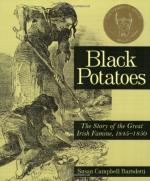|
This section contains 1,165 words (approx. 3 pages at 400 words per page) |

|
Chapter 2 Summary and Analysis
Ireland was fertile--its rivers and lakes, plentiful--and its vegetation, lush and green. By 1845, Ireland's population was about eight million. Population density was about one house per four acres (although many had much less). About a third worked as farm laborers, living in abject poverty. Visitors were amazed that such raggedly clad men and women--and nearly naked children--could exist in the United Kingdom. Ireland's land system was blamed for the poverty of three-eighths of its population. The Industrial Revolution with its factory and mill jobs had not reached Ireland as it had Britain and the United States. Most of Ireland's economy was agricultural. The Irish fell into three classes: landowners, farmers, and farm laborers. Most landlords, who lived in Britain, hired agents to manage their property. Management consisted of collecting rent. There was no land improvement. The landlords rented parcels of land...
(read more from the Chapter 2 Summary)
|
This section contains 1,165 words (approx. 3 pages at 400 words per page) |

|




